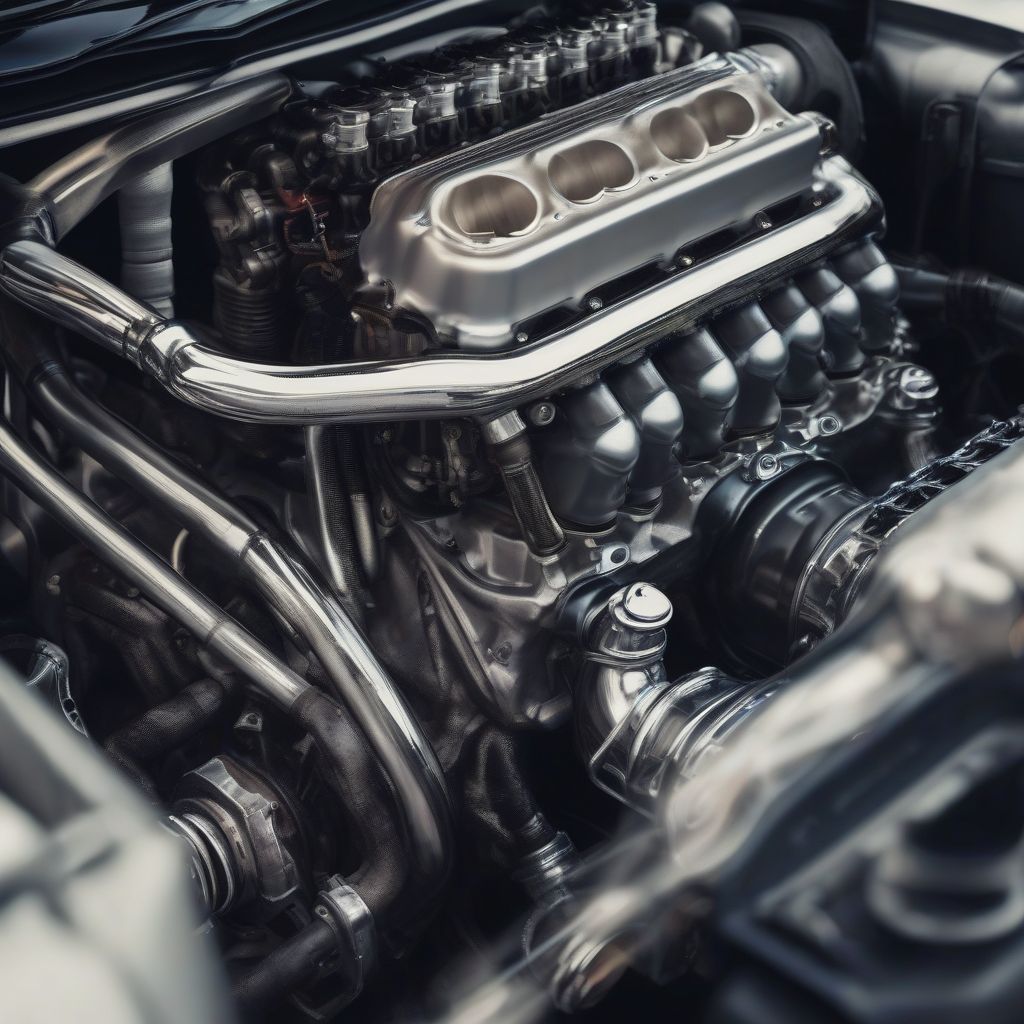What is Race Gas and Why Does It Fuel High-Performance Engines?
The roar of a high-performance engine, the smell of burning rubber, the thrill of speed – these are the sights and sounds of motorsports. But behind the scenes, there’s a powerful force driving these machines to their limits: race gas. So, What Is Race Gas, and what makes it different from the fuel you pump into your daily driver?
Understanding the Fuel That Powers Champions
Race gas, also known as racing fuel, is a high-octane gasoline specially formulated for high-compression, high-performance engines found in racing vehicles. It’s engineered to withstand extreme conditions and deliver maximum power output without causing detonation, also known as engine knocking.
 Race Car Engine
Race Car Engine
Why Race Gas Matters: The Science Behind the Performance
The key difference between race gas and regular gas lies in their octane ratings. Octane rating is a measure of a fuel’s resistance to detonation or knocking. Detonation occurs when the fuel-air mixture in the engine’s combustion chamber ignites prematurely, creating competing pressure waves that can damage the engine.
Race gas has a higher octane rating than regular gas, typically ranging from 100 to 120 or even higher. This higher octane rating allows race engines with higher compression ratios and forced induction systems (like turbochargers or superchargers) to operate at peak performance without experiencing harmful detonation.
Here’s why this matters:
-
Higher Compression Ratios: Race engines are designed with higher compression ratios, which squeeze the fuel-air mixture more tightly before ignition. This increased compression generates more power but also increases the risk of detonation. High-octane race gas resists detonation, allowing these engines to run higher compression ratios safely.
-
Forced Induction: Turbochargers and superchargers force more air into the engine, increasing power output. However, this also increases cylinder pressure and the likelihood of detonation. Race gas’s resistance to knocking ensures that engines equipped with forced induction can handle the added stress and deliver maximum performance.
Delving Deeper: The Composition of Race Gas
Race gas is not a one-size-fits-all fuel. It comes in various blends tailored to specific racing disciplines and engine configurations. The precise composition can vary depending on factors such as:
-
Octane Requirement: Different racing classes and engine setups have varying octane requirements.
-
Fuel System Compatibility: Some race fuels are designed for use with specific fuel systems, such as those found in methanol-fueled drag racing engines.
-
Environmental Regulations: Some racing organizations have rules and regulations regarding fuel composition and emissions.
Common components of race gas include:
-
High-Octane Base Stock: Race gas starts with a base stock of gasoline that has a naturally higher octane rating than pump gas.
-
Octane Boosters: Additional octane-boosting additives are blended in to achieve the desired octane rating.
-
Oxygenates: Some race fuels contain oxygenates, such as ethanol or methanol, which can improve combustion efficiency and power output.
-
Detergents and Lubricants: Race gas may include detergents to keep fuel systems clean and lubricants to reduce friction.
gas.areview.net/wp-content/uploads/2024/09/race-car-fueling-66dff4.jpg" alt="Race Car Fueling" width="1024" height="1024">Race Car Fueling
Race Gas vs. Pump Gas: A World of Difference
While it might be tempting to think of race gas as simply a more potent version of pump gas, the differences are significant:
-
Octane Rating: As discussed, race gas has a significantly higher octane rating, making it unsuitable for standard vehicles.
-
Energy Content: Race gas often has a lower energy content per unit volume compared to pump gas. This means that race cars typically consume more fuel to produce the same amount of power.
-
Cost: Race gas is considerably more expensive than pump gas due to its specialized formulation and limited production.
-
Legality: Using race gas in vehicles not specifically designed for it is illegal in many places and can damage standard engines and emissions systems.
The Importance of Choosing the Right Fuel
Selecting the correct race gas for a particular application is crucial. Using a fuel with an octane rating that is too low can lead to detonation and engine damage, while using a fuel with an unnecessarily high octane rating can result in reduced performance and increased costs.
Beyond the Racetrack: Race Gas in Other Applications
While primarily associated with motorsports, race gas also finds applications in other areas where high-performance engines are used, such as:
-
Aviation: Some high-performance aircraft engines use aviation gasoline with similar characteristics to race gas.
-
Marine: High-performance boats and personal watercraft may also benefit from race gas.
Conclusion: Fueling the Need for Speed
Race gas is an essential component of the high-octane world of motorsports, providing the necessary fuel for pushing engines to their limits. Its unique formulation and high octane rating allow racing engines to operate at peak performance while preventing detonation. Understanding the science behind race gas and its differences from regular gasoline is crucial for both racing enthusiasts and anyone curious about the technology that fuels these powerful machines.